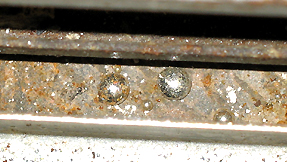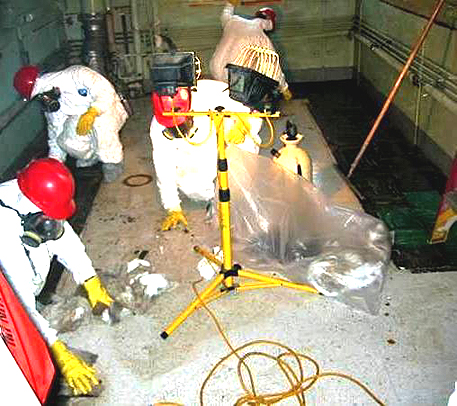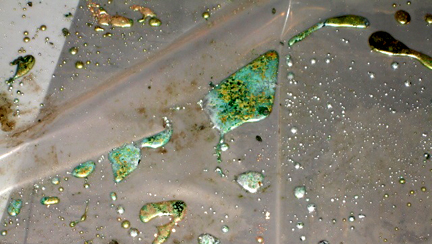
| T H E N I H C A T A L Y S T | J A N U A R Y – F E B R U A R Y 2008 |
|
|
|
MERCURY FALLING . . . AND SPILLING—BUT THERE'S A PLAN FOR A MERCURY-FREE NIH |
|
|
Sandwiched between gold and thallium on the periodic table—and, unfortunately between the carpets and floors and in drawers, plumbing, and vacuum lines in many NIH labs—lies mercury, a well-studied neurotoxin.
Research at NIH in the 1940s confirmed the occupational hazard that mercury posed, which led to a ban on its use in hat making. It is with a twist of irony, then, that mercury spills remain one of the most common HAZMAT response calls from NIH facilities.
Many NIH labs, unnecessarily, still use mercury-containing instruments, such as thermometers, thermostats, and switches. Some older buildings have years’ worth of mercury accumulation; some new buildings are heading down the same path.
Highly toxic and persistent in the environment, mercury—atomic number 80 and public enemy number one for the ORF Division of Environmental Protection (DEP)—is readily dispersed when dropped and can be very expensive to clean up.
Mercury from spills and from disposal of mercury-contaminated chemicals such as bleach that enter the sewage system can ultimately result in pollution of waterways. Indoors, spills pose acute inhalation and dermal contact hazards and may add to body burdens of the element.
Even in a fanciful world of no spills, the general use and disposal of mercury is still a problem because it cannot be destroyed, only extracted and recycled. Reprocessing and final containment is expensive, and there are few environmentally friendly disposal options.
While Congress has proposed legislation to establish secure repositories and ban exports, much of the recovered mercury is currently sold for reuse, often in developing countries.
The NIH Clinical Center established a program in the late 1990s to remove mercury-containing products. The Mayo Clinic and many other leading biomedical research facilities also have gone mercury-free.
Ed Rau, a DEP environmental health officer in charge of mercury cleanup, and DEP Director Kenny Floyd want to make the rest of NIH mercury-free. They have proposed to the Office of Intramural Research and the NIH Scientific Directors a plan to ban the procurement of mercury-containing devices by the end of 2008 and to eliminate all uses of mercury in labs by the end of 2009.
"For virtually all laboratory needs, there are mercury-free alternatives," said Rau. There are costs associated with purchasing replacements, but these are minuscule compared with the potential costs of spill cleanup, he observed.
Rau added that as the largest biomedical research facility in the world, "we should use our buying power to drive the market to develop better, less toxic products, which would benefit both science and the environment."
 |
 |
|
Ed
Rau |
Kenny
Floyd |
Legacies of Past Use
Floyd’s team assesses levels of mercury and other hazardous substances in NIH labs and buildings as part of a decommissioning protocol carried out before renovations or demolition.
 |
|
photos
courtesy of the Division of Environmental Protection, NIH, and Scott Neese,
3D EnviroLogics LLC
Mercury droplets |
Mercury is detected by combination of visual observations (looking for telltale silvery droplets under flooring and in sink traps), analysis of solid residues (from pipes and soil, for example), and air sampling (using a highly sensitive portable atomic absorption spectrophotometer).
Air readings in laboratories with active ventilation systems are well below the permissible exposure level of 100,000 ng/m3 set by OSHA years ago. Because of mercury’s tendency to bioaccumulate, however, more recent guidelines developed by the Agency for Toxic Substances and Disease Registry and EPA have set no-health-effect levels for the general population far lower, from 200 to 300 ng/m3.
Surveys of spaces in Building 3 in 2002 revealed that about a third of the labs had air mercury concentrations over 250 ng/m3, over 10 times the building background level.
Using the mercury meter, Floyd said they were able to follow trails of mercury contamination from one lab where spills were evident into restrooms, cold rooms, and offices, suggesting tracking underfoot and the potential to bring home contamination on shoes and clothes. Floyd is also worried about carrying bad habits into the newer NIH facilities.
 |
Building
3 decontamination team |
"If we bring mercury into the new buildings, we can only surmise we’ll have problems down the road," he said. Spills already have occurred in two of our newest buildings, 33 and 35.
Paramount among problems presented by spills is the cleanup cost. Demolition debris containing as little as 200 micrograms of mercury per liter of extract must be disposed of as hazardous waste.
A very small volume of mercury can contaminate tons of material. Removal of hazardous substances and contamination in Building 3 was approximately $1 million; about 75 percent of the total cost was mercury decontamination and disposal. Initial studies began in the spring of 2002, and the actual decontamination began in December 2002 and was fully complete by late February 2004.
Mercury is indeed the top toxic concern as NIH renovates old labs, Rau said. Lead and asbestos are relatively easy to locate and remove. Mercury moves and spreads, as the name quicksilver implies.
 |
Mercury
spill from lab building (6) vacuum line |
Cleanup in active labs, in response to spills, is especially problematic. When mercury gets behind casework or under floor tiles, cleanup usually requires removal of these items, shutting down the lab and disrupting science for weeks.
Other Effects on Research
While the neurotoxic effects of mercury exposure are well established, there are lesser known, more insidious effects that could compromise research conducted in contaminated laboratories.
Rau suggests that low levels of mercury contamination in facilities could affect responses of laboratory animals. He notes that mercury is a potent immunomodulator that’s been found to affect the immune response of animals at very low levels of exposure, as low as 0.4 mg/kg body weight. This can result in hypersensitivity reactions and alterations in the host response to infectious agents.
Additionally, the presence of low levels of mercury in an environment has been shown repeatedly to favor development of antibiotic-resistant bacteria.
Bacterial resistance to mercury toxicity, probably developed since primordial times to cope with naturally occurring mercury, is located on the mercury-resistance locus (mer). This locus and the antibiotic-resistance integron In2 are both carried on the same transposon (T21).
Thus, mercury-contaminated environments select and enrich for populations with multiple antibiotic resistance—unwanted guests in clinical and biomedical research facilities.
A Mercury-free NIH
At first, Floyd said he’d like to pick what he calls the low-hanging fruit, the easily replaceable thermometers and reagents in the proposed mercury ban. Floyd said his office remains sensitive to the needs of scientists to obtain precision measurements and to continue ongoing research using the same instrumentation. Mercury-free models should be selected when the instrumentation is replaced.
For the mercury ban to work, however, Floyd said he needs to hear from the intramural research community to understand the extent of unavoidable uses of mercury.
The DEP has a proposed waiver process for research with no mercury-free alternatives. But the fact that the Clinical Center has gone mercury-free is evidence, he said, that world-class research need not be affected by the switch.
Standing exceptions to the ban would include energy-saving lighting. Although fluorescent bulbs contain a few milligrams of mercury, the energy saved by using them in place of incandescent bulbs results in far less mercury released into the environment as a result of coal-burning power generation.
Wheels in Motion
The DEP extended the Clinical Center’s voluntary mercury reduction program in 2001 to all NIH labs and facilities as an initiative called the "Mad as a Hatter? Campaign for a Mercury-Free NIH."
Rau is the self-declared NIH Mad Hatter, sometimes donning an alternate uniform—a big purple hat and bowtie—for publicity events. Mad, in this case, means angry about pollution and spills that don’t need to happen, especially in brand new lab buildings at NIH, Rau said.
Floyd sees the procurement ban and subsequent replacement of mercury-containing instruments as an extension of laws already in place but not strictly enforced.
Maryland is among several states that prohibit the sale of mercury thermometers and certain other mercury devices. And the DHHS Affirmative Procurement Plan of July 2006 prohibits use of mercury in aneroid manometers and temperature-measuring devices, electronic thermostats, mechanical switches, and ultrasonic and photoelectric sensors.
A more challenging but necessary part of procurement controls will be restrictions on purchases of chemicals such as certain brands of bleach that contain significant levels of mercury as an unintended contaminant arising from manufacturing processes.
Mercury Exposé
Mercury is ubiquitous, and researchers might not know they are using products containing mercury. To access a link to a list of procedures and products that involve or contain mercury, as well as links to a growing list of alternatives, visit this website.
Rau, an expert on management of hazardous substances, said he knows that reluctance to change boils down to lab culture.
One idea that could help, he said, would be for scientists to state in their published papers that the work was performed mercury-free, to improve awareness of mercury hazards and encourage the entire scientific community to make the switch to mercury-free alternatives. He would also welcome greater participation by scientists in establishing clean-up levels for mercury and other hazardous contaminants in laboratories.
"These
problems originate at the lab-bench level and so must the solutions," Rau
said.
![]()
For more information and to confer with DEP on mercury use and alternatives in your lab, Ed Rau may be contacted at 301-496-7775 or by e-mail. |